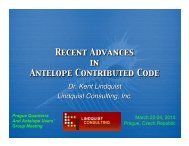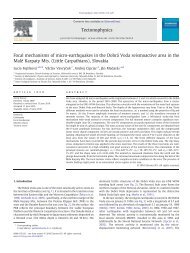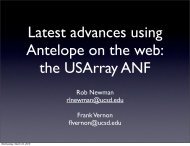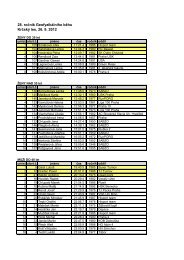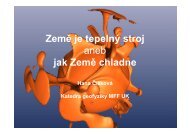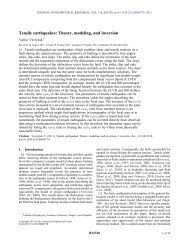Geophysical Institute of the ASCR
Geophysical Institute of the ASCR
Geophysical Institute of the ASCR
You also want an ePaper? Increase the reach of your titles
YUMPU automatically turns print PDFs into web optimized ePapers that Google loves.
to simulate <strong>the</strong> new LPO, hence exact reasons <strong>of</strong> <strong>the</strong> new LPO development remained unclear from<br />
<strong>the</strong> mechanical point <strong>of</strong> view (Ulrich and Mainprice, in review). A garnet LPO is generally weak even<br />
if grain shapes are strongly flattened and define a foliation plane. It is in agreement with numerical<br />
models. Clinopyroxene and garnet LPO’s have been used for <strong>the</strong> calculation <strong>of</strong> anisotropy and<br />
distribution <strong>of</strong> seismic waves in eclogites. The results showed very weak anisotropy and similarity in<br />
<strong>the</strong> distribution <strong>of</strong> seismic waves, which is due to a high percentage <strong>of</strong> garnet with weak LPO. The<br />
calculated reflection coefficient shows that mantle eclogites are barely detectable inside peridotites.<br />
References<br />
Brenker, F.E., Prior, D.J., Müller, W.F., 2002. Cation ordering in omphacite and effect on deformation mechanism and lattice<br />
preferred orientation (LPO). Journal <strong>of</strong> Structural Geology , 24, 1991-2005.<br />
Ulrich S. and Mainprice D., 2005. Does cation ordering in omphacite influence development <strong>of</strong> lattice-preferred orientation?<br />
Journal <strong>of</strong> Structural Geology, 27/3, 419-431.<br />
Ulrich S. and Mainprice D. A high-temperature lattice preferred orientation <strong>of</strong> naturally deformed omphacite. Earth and<br />
planetary science letters, submitted.<br />
Stratigraphic architecture <strong>of</strong> Cenomanian strata <strong>of</strong> <strong>the</strong> Bohemian<br />
Cretaceous Basin: relationships <strong>of</strong> depositional systems and<br />
reactivation <strong>of</strong> basement fault zones<br />
In 2004, a multi-disciplinary study <strong>of</strong> Cenomanian (Upper Cretaceous) strata was finalized in <strong>the</strong><br />
central and western part <strong>of</strong> <strong>the</strong> Bohemian Cretaceous Basin (Fig. 10). The aim <strong>of</strong> <strong>the</strong> project,<br />
supported by <strong>the</strong> Ministry <strong>of</strong> Environment, was to reconstruct <strong>the</strong> kinematic evolution <strong>of</strong> <strong>the</strong><br />
reactivated basement zones during <strong>the</strong> initial phase <strong>of</strong> filling <strong>of</strong> this basin, which occupies <strong>the</strong> Elbe<br />
Zone, a major crustal weakness <strong>of</strong> Central Europe. The basin recorded <strong>the</strong> most significant<br />
reactivation <strong>of</strong> this and o<strong>the</strong>r deep-seated tectonic structures <strong>of</strong> <strong>the</strong> Bohemian Massif between <strong>the</strong><br />
early post-orogenic phase in Late Paleozoic and <strong>the</strong> Eger Graben formation in <strong>the</strong> Cenozoic. The<br />
detailed insight into <strong>the</strong> formation and tectonic and paleogeographic evolution <strong>of</strong> <strong>the</strong> Bohemian<br />
Cretaceous Basin (BCB) is <strong>the</strong>refore fundamental for understanding <strong>the</strong> causes and mechanisms <strong>of</strong><br />
<strong>the</strong> far-field reactivation <strong>of</strong> major structures <strong>of</strong> <strong>the</strong> Bohemian Massif during <strong>the</strong> postorogenic phase.<br />
The Cenomanian-age (c. 99 – 93.5 Ma) strata <strong>of</strong> <strong>the</strong> Bohemian Cretaceous Basin, <strong>of</strong> fluvial, paralic,<br />
and shallow-marine origin, are particularly interesting for <strong>the</strong> proposed type <strong>of</strong> study because <strong>the</strong>y<br />
were deposited during <strong>the</strong> initial phase <strong>of</strong> basin formation and record an interplay <strong>of</strong> reactivation <strong>of</strong><br />
inherited basement fault zones and <strong>the</strong> long-term global sea-level rise that culminated near <strong>the</strong><br />
Cenomanian-Turonian boundary (e.g., Uličný et al., 1997, Uličný et al., 2004).<br />
The broad range <strong>of</strong> methods used included genetic sequence stratigraphy based on well-log, core, and<br />
outcrop sedimentological data, biostratigraphy (macro- and micropalaeontology) and palynological<br />
analysis, heavy mineral analysis, evaluation <strong>of</strong> regional gravity maps, structural maps, digital<br />
elevation models, and archive seismic reflection pr<strong>of</strong>iles. A grid <strong>of</strong> 2D stratigraphic correlation<br />
sections was used for construction <strong>of</strong> isopach maps for <strong>the</strong> newly defined genetic stratigraphic units<br />
(CEN 1 – 6), and <strong>the</strong> comparison <strong>of</strong> <strong>the</strong>se data with <strong>the</strong> structural framework <strong>of</strong> <strong>the</strong> basin allowed <strong>the</strong><br />
syn-depositional activity <strong>of</strong> <strong>the</strong> basement faults to be interpreted.<br />
The main control on formation <strong>of</strong> topography and on distribution <strong>of</strong> subsidence and uplift was <strong>the</strong><br />
reactivation <strong>of</strong> <strong>the</strong> conjugate set <strong>of</strong> two main fault systems. The “Elbe” system faults (WNW to NWdirected)<br />
acted as dextral oblique-slip faults whereas <strong>the</strong> “Jizera” system faults (NNE-directed, such<br />
as <strong>the</strong> Blanice-Rodl lineament) has a sinistral sense <strong>of</strong> slip. The principal horizontal stress vector had<br />
a generally northwestern orientation.<br />
25



